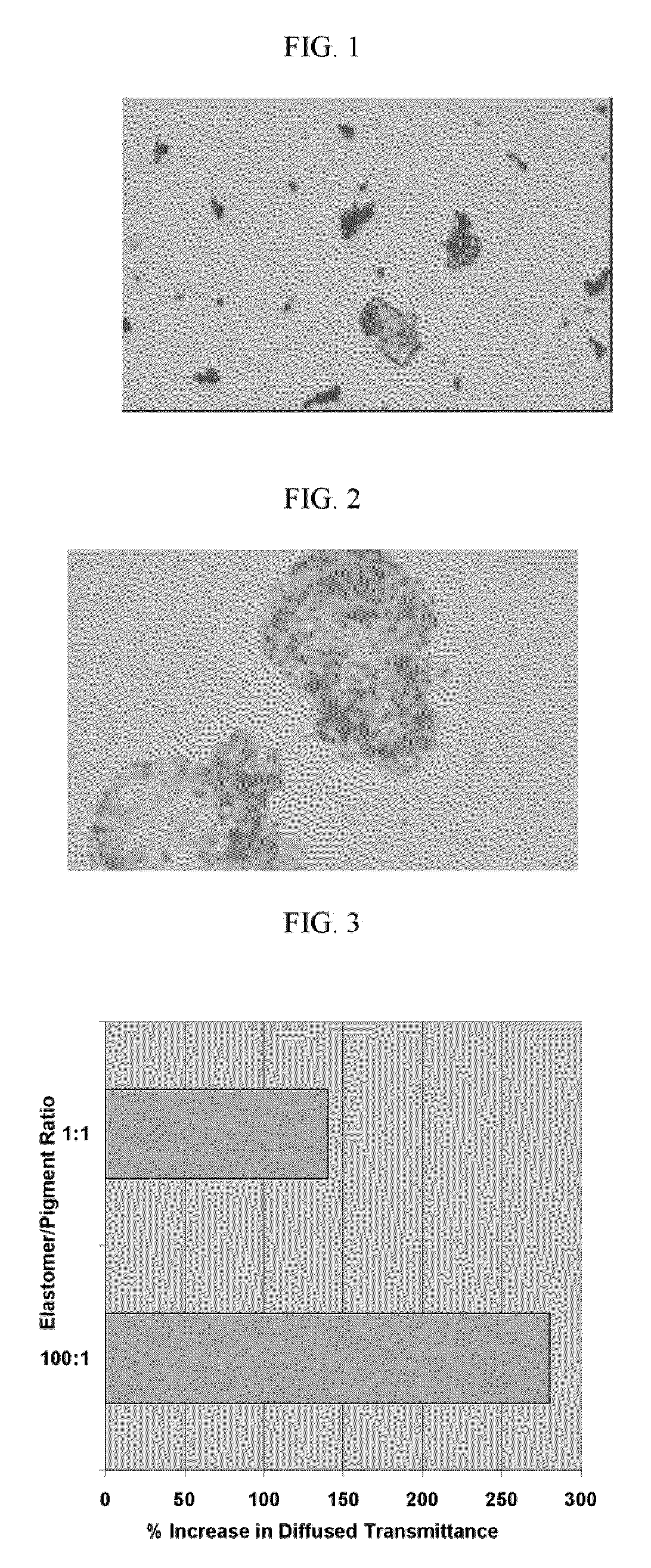Method of Improving Skin Appearance Using Treated Macroscopic Particles
- Summary
- Abstract
- Description
- Claims
- Application Information
AI Technical Summary
Benefits of technology
Problems solved by technology
Method used
Image
Examples
example 1
Preparation of Surface-Treated Macroscopic Material by Mechanofusion
General Procedure
[0072]Various sample formulations of surface-treated macroscopic materials made of the ingredients and combinations illustrated in Table I were loaded in the sample mechanofusion chamber of a HOSOKAWA MICRON MECHANOFUSION SYSTEM® AMS-Mini (Hosokawa Micron Ltd; Osaka, Japan). Each sample formulation was run in the sample mechanofusion chamber at 1600 RPM for 20 minutes at about 25-30° C. Afterwards, the sample mechanofusion chamber was inspected to ensure that all particles were in the main mixing chamber. Finally, the sample was mixed for a second time at 1600 RPM for 20 minutes at about 25-30° C.
[0073]Using the above procedure, compositions or formulations shown in Table I were prepared including the surface-treated macroscopic materials. All amounts are in percent by weight.
TABLE IIngre-Formulations:dients123456789Macro-907060403050607070scopicmaterialPigment10304060700000BlendFumed0000025201510...
example 2
Preparation of Surface-Treated Macroscopic Material by Physical Adsorption from Solution
[0074]A surface-treated macroscopic material was formed by combining Part A and Part B, both of which are detailed below.
[0075]A hydrocarbon modified silicone crosspolymer macroscopic material manufactured by Momentive Performance Materials (Fairfield, Conn.) and sold under the tradename VELVESIL™ 125 was dispersed in (55 wt %) solvent cyclo-pentacyclomethanone D5 (hereinafter, “Part A”) at room temperature using a lab overhead stirrer equipped with a 3 blade mixing propeller for 20 minutes. Alkyl silane treated-TiO2 (0.2 wt %) inorganic particle was then dispersed in cyclo-pentacyclomethanone D5 solvent (hereinafter, “Part B”) in a separate beaker using a lab overhead stirrer equipped with a 3 blade mixing propeller and mixed at about 400-600 RPM for 20 minutes at room temperature. A pigment surface-treated macroscopic material in gel form was prepared by mixing the hydrocarbon modified elasto...
example 3
Preparation of Surface-Treated Macroscopic Material by Pre-Emulsification
[0078]A surface-treated macroscopic material was formed by combining Part A and Part B, both of which are detailed below.
[0079]Part A, the pre-emulsion mixture, was formed by combining 2.97 g of a commercially available mixture of pre-polymer, cross-link initiator catalyst, and curing agent with 6.95 g of methyl trimethicone in a 50 mL container. Afterwards, 2.47 g of Dow Coming DC 5330 emulsifier was added and the combination was mixed until homogeneous.
[0080]Part B was formed by adding 100 mL of water to a 500 mL circular container with an overhead stirrer and a four-blade mixing paddle. Afterwards, 80 mg of dimethicone-treated-TiO2 (commercially available from Kobo Products, Inc., South Plainfield, N.J.) as added and the entire mixture was vigorously stirred at about 400-600 RPM at room temperature.
[0081]Part A was poured into the 500 mL mixing and stirring device containing Part B. This combination was vi...
PUM
| Property | Measurement | Unit |
|---|---|---|
| Time | aaaaa | aaaaa |
| Pressure | aaaaa | aaaaa |
| Pressure | aaaaa | aaaaa |
Abstract
Description
Claims
Application Information
 Login to View More
Login to View More - R&D
- Intellectual Property
- Life Sciences
- Materials
- Tech Scout
- Unparalleled Data Quality
- Higher Quality Content
- 60% Fewer Hallucinations
Browse by: Latest US Patents, China's latest patents, Technical Efficacy Thesaurus, Application Domain, Technology Topic, Popular Technical Reports.
© 2025 PatSnap. All rights reserved.Legal|Privacy policy|Modern Slavery Act Transparency Statement|Sitemap|About US| Contact US: help@patsnap.com

